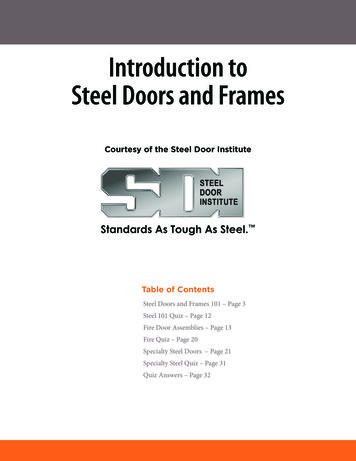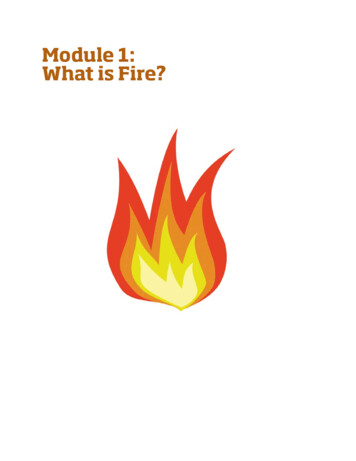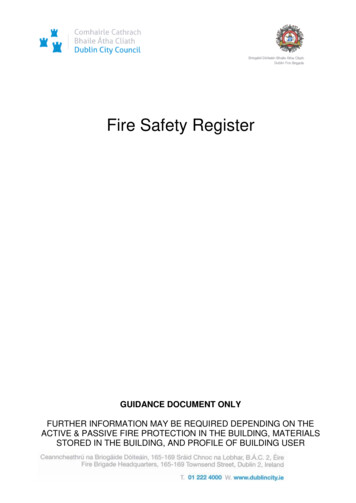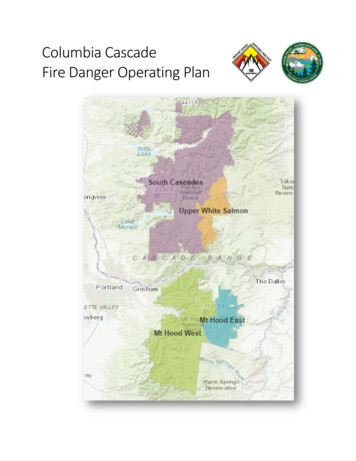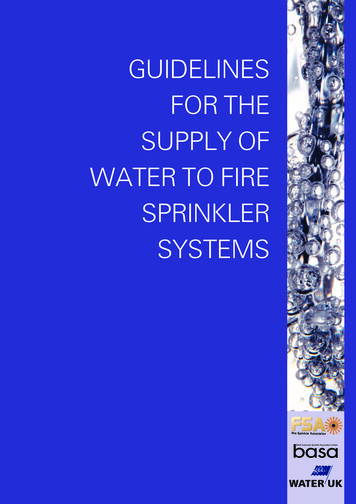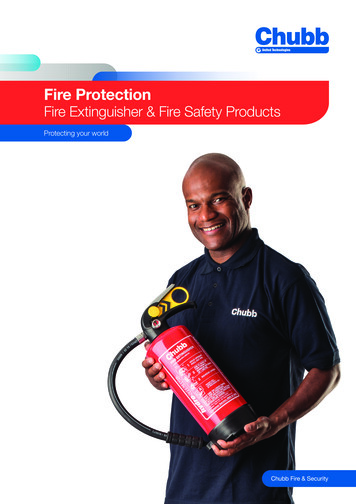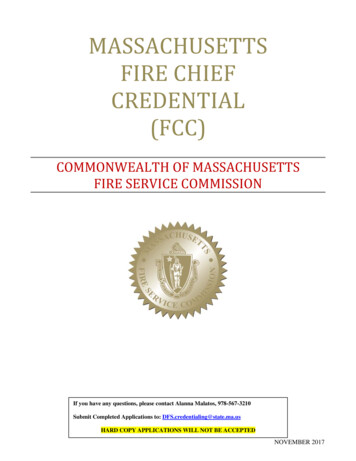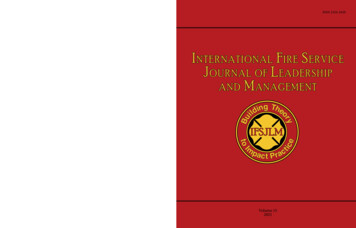
Transcription
ISSN 1554-3439I nternational F ire S erviceJ ournal of L eadershipand M anagementVolume 152021
Volume 15Peer-Reviewed ArticleDr. Lori Moore-Merrell, International Public Safety Data Institute, Chantilly, VA, USADr. Steve Kerber, Fire Safety Research Institute, Underwriters Laboratories, Columbia, MD, USADr. Gavin P. Horn, Fire Safety Research Institute, Underwriters Laboratories, Columbia, MD, USA, and Universityof Illinois, Fire Service Institute, Urbana-Champaign, IL, USADr. Denise L. Smith, University of Illinois, Fire Service Institute, Urbana-Champaign, IL, USA, and SkidmoreCollege, Saratoga Springs, NY, USAEffects of Crew Size on Firefighter Health and SafetyAbstractFirefighters’ safety during fire responses depends on sound policies and procedures that ensure theycan do their jobs efficiently and effectively. Decisions on vehicle crew size and total effective responseforce deployment should be based on the best available evidence. It is imperative that fire department leaders and political decision makers understand how the fire department resource deployment impacts community safety related to civilian injury and death, firefighter injury and death, andproperty loss. This state-of-the-art review provides a comprehensive examination of (a) results frommultidisciplinary (e.g., engineering, medicine, fire technology, and social sciences) research efforts,(b) published data, (c) industry standards, and (d) expert opinion. The review examines the effectof emergency response vehicle crew size and total effective response force deployment on firefighters’ health and safety risks, recognizing that firefighter health and safety is necessary to ensure thatfirefighters can effectively perform their jobs and protect their community. We conclude, based onavailable evidence, that the crew sizes and the effective response force sizes recommended in NFPA1710, Standard for the Organization and Deployment of Fire Suppression Operations, Emergency Medical Operations, and Special Operations to the Public by Career Fire Departments, should be consideredthe minimum to provide for firefighters' health and safety. Whenever possible, additional resourcesshould be provided to address firefighter physiological stress, limit fire growth, and mitigate occupational exposure in today’s rapidly evolving fireground.Keywords: firefighter, crew size, health and safety, effective response forceIntroductionFire chiefs are often faced with policies created by municipal officials who are challenged to balance community service expectations with finite budgetary resources. Unfortunately, many officials who are acutelyaware of budgetary challenges often lack the solid technical foundation they need to properly evaluate theimpact of staffing and deployment decisions on the safety of the public and firefighters. This often resultsin planning fire department resources to meet budget needs, rather than budgeting to ensure the properresource allocation and deployment to meet critical service and safety needs.Effectively managing a fire department requires proper emergency resource allocation to known riskenvironments in local communities. It is imperative that fire department leaders, as well as political decision makers, consider how fire department resource deployment in their local community affects community outcomes in three important areas: (1) civilian injury and death, (2) firefighter injury and death, and (3)property loss. This article focuses on fire department response to structure fires and the resulting impact onfirefighter safety, injury, and death.Fire continues to be a devastating event in communities across the country, with structure fires accounting for most civilian casualties. National Fire Protection Association (NFPA) estimates indicate that structure fires account for only 38% (499,000) of fires nationwide, and 72% (357,000) of structure fires in homes.Structure fires account for a disproportionate share of losses: 77% (2,630) of fire deaths, 83% (12,160) of fireinjuries, and 10.7 billion of direct dollar losses (Evarts, 2018).Community leaders recognize that fire protection is an essential service, and more than 32,000 firedepartments operate with a mandate to protect lives and property of residents and visitors in theirIFSJLM7
International Fire Service Journal of Leadership and Managementcommunity. Although the overarching goal of the fire service is to prevent fires by ensuring proactive protections like fire alarms, smoke alarms, and automatic sprinklers are in place, the sad reality is that structure fires still occur. Therefore, there is an obligation to assess personnel resources deployed to these events,the environment in which they work, and the physical effects on responding firefighters.Fire departments must establish policies on response crew size and total effective response force (ERF)deployment, incident arrival, and assembly in order to ensure operational effectiveness and fulfill theirresponsibility to protect their communities. In addition, fire departments have an obligation to consider thehealth and safety of the firefighters they deploy to face hazardous working conditions. These conditions arebecoming more hazardous due to changes in building construction and modern furnishings.NFPA 1500TM, Standard on Fire Department Occupational Safety, Health, and Wellness Program, addressesresponse resources in the context of firefighter health and safety, but it stops short of definitively linkingthe effects of different crew sizes on responding vehicles to the health and safety of firefighters. The industry standard — NFPA 1710, Standard for the Organization and Deployment of Fire Suppression Operations,Emergency Medical Operations, and Special Operations to the Public by Career Fire Departments — detailsthe resources needed to adequately respond to different types of hazards and has implications for firefighterhealth and safety. NFPA 1720, Standard for the Organization and Deployment of Fire Suppression Operations,Emergency Medical Operations, and Special Operations to the Public by Volunteer Fire Departments, is a companion document for volunteer fire departments, but it is not based on performance objectives as is NFPA1710.Regardless of fire department organization and the NFPA standard(s) followed, protecting firefighterhealth and safety is an obligation of the fire chiefs and elected officials who oversee fire departments. Thisobligation is critical to protecting the community, as it ensures that firefighters can perform their essentialpublic safety work. To make staffing decisions, leaders must understand how the size of responding crewsand the timeliness of ERF assembly affect firefighter health and safety.This review synthesizes research from multiple disciplines in order to: Detail the health and safety risks that firefighters face as they perform firefighting work Describe the work activities that firefighters must perform Characterize the work environment in which firefighters perform their duties Discuss the effect of response crew size and the timing of ERF assembly on firefighter health and safety Provide recommendations for policy makers to ensure effective and safe deployment of resourcesFirefighter Health and Safety RisksFirefighting is widely acknowledged as a dangerous occupation. Between 2009 and 2018, NFPA reportedthat 701 firefighters died in the line of duty, including 599 municipal firefighters from career and volunteerdepartments (Fahy & Molis, 2019, and reports from previous years). Table 1 presents the number of fatalitiesfor municipal firefighters by cause and nature for the 10-year period between 2009 and 2018 as reported bythe NFPA. In 323 (53.9%) of the 599 duty-related municipal firefighter deaths in the past ten years, overexertion/stress/medical was listed as the cause of death. Sudden cardiac death was the nature of fatality mostcommonly reported by the NFPA. Stroke, a condition related to blood vessels in the brain, was identified asthe nature of the fatality in another 29 firefighters, meaning that cardiovascular disease was responsible formore than half of line-of-duty deaths reported by the NFPA in the past 10 years. Internal trauma and crushing, asphyxiation and smoke inhalation, and burns were responsible for another 252 firefighter fatalities.In addition to the fatalities addressed above, Table 2 shows over 665,000 injuries were reported duringthis 10-year period, and it is widely acknowledged that injuries are underreported (see Campbell & Molis,2019, and previous reports in the series). The majority of injuries were due to strains, sprains, and muscularinjury. Some of these injuries include serious back or joint injuries that can require long treatment periodsand expensive backfilling of positions. Over 7,000 firefighters suffered non-fatal cardiac events and strokesduring the 10-year period. Burns, smoke inhalation, or the combination of the two resulted in injuries to48,550 firefighters.8IFSJLM
Volume 15Table 1Career and Volunteer Municipal Firefighter Fatalities Over a 10-Year Period (2009-2018)Cause of the Fatality as Reported by the NFPANumber of FatalitiesPercent of Total k by object6110.2%Motor vehicle crashes477.9%Lost inside/caught or trapped416.8%Fell355.8%Struck by vehicle274.5%Structural collapse254.2%Rapid fire progress233.8%Other172.8%Number of FatalitiesPercent of Total FatalitiesSudden cardiac death28747.9%Internal trauma & crushing17929.9%Asphyxia including smoke %TOTAL599100%aNature of the Fatality as Reported by the NFPASource: Campbell & Molis, 2019, and previous reports in the series.Note. This table does not include data from non-municipal firefighters, which may include employees of forestry agencies, industrial firebrigades, the military, the federal government, prison crews, and impressed civilians as described at ities-in-the-United-States/Firefighter-deaths. This list does notinclude firefighters at the World Trade Center, September 11, 2001.aOther includes assault/murder, exposed to electricity, exposure, and caught underwater.bOther includes gun shot, unspecified medical, drowning, electrocuted, suicide, drug overdose, asthma, and pneumonia.Table 2Firefighter Injuries over a 10-Year Period (2009-2018)Nature of the Injury as Reported by the NFPANumber of InjuriesPercent of Total InjuriesBurns (fire or chemical)20,7203.2%Smoke or gas inhalation20,4452.9%Burns and smoke inhalation7,3851.0%Other respiratory distress9,2801.4%Strain, sprain, muscular pain365,86055.3%Wound, cut, bleeding, bruise100,34515.2%Thermal stress (frostbite, heat exhaustion)25,7653.8%Dislocation, 5,970100.0%Cardiovascular disease (heart attack/stroke)Source: Campbell & Molis, 2019, and previous reports in the series.IFSJLM9
International Fire Service Journal of Leadership and ManagementCalculating the number of injuries and fatalities may be easier than understanding what causes them.There are many hazards that lead to injury and fatalities, including fire, smoke, building components thatfail and collapse, and pathophysiological responses to the stress of firefighting. A firefighter may be injuredor killed by one acute event or a combination of events. One event may lead to another more serious injury,such as trauma from a fall leading to burns or asphyxiation when the firefighter becomes trapped underdebris. Fire departments must understand the risks that firefighters face and plan their responses to ensurethey can meet the operational needs of firefighting and mitigate risk appropriately. By considering these factors, policy makers can take meaningful steps to mitigate risk.In addition to the acute risks that firefighters face, chronic exposure to products of combustion canhave long-term impacts on firefighters’ health. The National Institute for Occupational Safety and Health(NIOSH) has found cancer incidence and mortality rates in firefighters to be significantly higher than thenational average. Mesothelioma and cancers of the esophagus, intestine, kidney, and oral cavity are particularly prevalent in firefighters. Research also shows an exposure-response relationship for lung cancerand leukemia (Daniels et al., 2014, 2015; Pinkerton et al., 2020). The International Association of Fire Fight ers (n.d.) reports that occupational cancers accounted for 66% of the line-of-duty deaths among their membership of active and retired firefighters between 2002 and 2019. It is important to note that cancer-relateddeaths are not included in the NFPA statistics reported earlier.Figure 1 depicts the health and safety risks that a firefighter faces in the context of the firefighting workperformed, the environment in which it is performed, and the physical, physiological, and psychologicalstrain it places on the firefighter. The following subsections address some of the major health and safetyrisks that firefighters face and discuss the complex interactions between different types of risk that increasethe potential for injury and death in the line of duty.Figure 1Relationship Between Firefighter Health and Safety Risks, and Firefighting Work, and the Firefighting EnvironmentFirefightingHealth and SafetyRiskFactors MediatingRiskForcibleEntrySearch mentalFire / Fire Growth / FlashoverToxic Environment / Structural Integrity Burn Asphyxiation Structural collapse Entrapment Trauma Fireground chemical exposures– Vapors– ParticulateOverhaul /Salvage WorkUtilityControlFirefighterFatigueOverstress / Overexertion Impaired cognitivefunction Decreased situationalawareness Inability to continuework Hyperthermia Cardiac risk Musculoskeletal injuryBurns and AsphyxiationPerhaps the two most readily recognized risks that firefighters face are burns and asphyxiation due tothe hot, smoke-filled environment in which they work. These conditions can occur separately or in combination. Burns and asphyxiation occur most often when fire conditions change rapidly, overcoming a firefighter. They also occur when a firefighter becomes lost or trapped due to the collapse of building structuresor the excessive fatigue that makes escape impossible or that impairs cognitive function. Burn injuries varyin severity, depending on the type, depth, and extent of the burning. Severe burns can be fatal.10IFSJLM
Volume 15Structural Collapse/Trauma/EntrapmentTraumatic injuries are a broad category of sudden onset physical injuries that require immediate medicalattention and can lead to death. Any part of the body can be injured by trauma, and traumatic injuries canvary greatly in severity. Traumatic injuries include crushing injuries, head injuries, and back injuries. Whilethe traumatic fatalities are devastating, traumatic injuries can lead to multiple surgeries and require monthsor years of rehabilitation.There are numerous ways that a firefighter can be injured or killed by traumatic events on the fireground.Building components can collapse and fall on a firefighter, or firefighters can fall through floor or roof systems that have been structurally compromised. Firefighters can fall from ladders or elevated work locationsthat are necessary to complete fireground missions. Uncontrolled fire growth provides the greatest risk forstructural collapse. Structural collapse can lead to trauma, entrapment, and/or burns and asphyxiation,further exemplifying the overlapping nature of the risks that firefighters face.Chemical Exposure RiskMore than ever, firefighters are becoming aware of chemical exposure risks on the fireground. Firesinvolving common household furnishings in residential structures can produce hundreds of compounds,including those that exist primarily in the vapor phase (e.g., benzene, styrene, 1,3-butadiene, formaldehyde,vinyl chloride, dioxins) and those that exist primarily in the solid phase (Austin et al., 2001; Jankovic et al.,1991). Many of these compounds are known or probable human carcinogens.Fireground exposures can be experienced through inhalation, ingestion, and dermal absorption. Inhalation is the most direct route of exposure for firefighters who do not wear respiratory protection inside oroutside the structure. Products of combustion may also be absorbed through the skin. The longer a chemicalis present on the skin, the more time is available for transdermal absorption.FatigueFatigue is a natural result of firefighting activity because firefighters perform heavy muscular work whilewearing heavy, insulative, and protective clothing. However, the potentially dangerous results of excessivefatigue are seldom addressed. In addition to causing medical events related to overexertion, fatigue candecrease the physical work firefighters can perform. An impaired ability to perform the time-critical workof applying water to the fire can allow the fire to grow, placing both civilians and firefighters at greater risk.Fatigue can also decrease situational awareness because changes in cognitive function may jeopardize afirefighter’s ability to make sound decisions.Overexertion/Medical EventsThere are numerous injuries and fatalities that are broadly attributed to overexertion. The most commonmedical issue encountered on the fireground is heat exhaustion. Firefighters who perform heavy muscularwork while wearing personal protective equipment (PPE) have an increase in core body temperature thatcan lead to heat exhaustion. Most firefighters who suffer heat exhaustion will recover if they are providedwith appropriate cooling, hydration, and rest. Heat stroke, the complete breakdown of the body’s ability tothermoregulate, is a more serious and rarer condition than heat exhaustion.Musculoskeletal injuries are also more likely in a firefighter who is fatigued. Deteriorating biomechanics and/or impaired cognitive functions make recognizing hazards more difficult. These injuries, includingsprains and strains, result in more than 50% of reported injuries.Cardiovascular EventsCardiovascular events are a major concern in the fire service. Research demonstrates that firefightingactivity dramatically increases the risk of suffering a sudden cardiac event. In fact, a firefighter is 10 to 100times more likely to suffer sudden cardiac death after firefighting than a firefighter engaged in non-emergency duties (Kales et al., 2007; Smith, Haller et al., 2019). More than 7,000 firefighters suffered non-fatal,duty-related cardiovascular events in the last 10 years (Campbell & Molis, 2019, and previous reports in theseries).IFSJLM11
International Fire Service Journal of Leadership and ManagementAs outlined in Figure 2, cardiovascular events may be triggered in vulnerable individuals by multiplestressors that are part of firefighting work, including physical exertion, activation of the sympathetic nervous system, heat stress and dehydration, and exposure to smoke and particulate matter. Research of thegeneral population has shown that strenuous physical work, sympathetic stimulation, and particulatematter are all factors that increase the risk of sudden cardiac death (Mittleman, 2007; Willich et al., 1993).Firefighters are exposed to all these risk factors and often to a greater extent than the public.Figure 2Model Linking the Physical and Physiological Stress of Firefighting to Cardiovascular Responses and to Potential Triggering of aCardiovascular EventFirefightingPhysicalWorkSympathetic NervousSystem ActivationHeat Stress andDehydrationIndividual CharacteristicsType of WorkCardiac Heart Rate Myocardial demand Stroke volumeSmoke, Toxins,Particulate MatterVascular Arterial stiffness Endothelial dysfunction Plaque instabilityCardiac Plasma volume Platelet number and function Coagulatory potentialPlaque Rupture/Thrombus FormationArrhythmiaSuddenCardiac Deathor OtherCVD EventSource: Smith et al., 2013.Firefighting WorkThe health and safety risks that firefighters face are multifactorial and often overlap. These risks aredirectly related to the work firefighters perform and their work environment.Firefighting crews must address four priorities at a fire scene:1. Life safety of occupants and firefighters2. Confinement and extinguishment of the fire3. Property conservation4. Reduction of adverse environmental impact12IFSJLM
Volume 15Firefighting personnel conduct interdependent and coordinated activities to meet these priority objectives. Specific tasks, such as advancing a hose line to the fire, ventilation, and search and rescue, can beconducted simultaneously or sequentially. Conducting these activities simultaneously is the most efficientmanner. Performing tasks sequentially can limit coordination and delay tasks on the fireground, contributing to rapid fire growth and escalating risk.Each arriving emergency vehicle (fire engine or truck) transports firefighters to the scene. The group offirefighters associated with a particular emergency vehicle is called a fire crew or fire company. Accordingto NFPA 1710 (2020), the minimum crew size is four firefighters, including one designated as an officer. Thisrequirement is important to understand as on scene tasks and risks are explained.Because every fire can present a unique set of conditions, fire department leaders should match themobile and personnel resources they deploy to the risks they are likely to encounter at the scene. The risksvary according to building size, structure type, and occupancy load. NFPA 1710 identifies four structurecategories:1. Single-family2. Open-air strip malls3. Garden-style apartment buildings4. High-rise buildings greater than 75 feet (23 m)The standard also indicates the minimum number of firefighters who must be available on scene for “lowhazard” single-family dwelling responses (16), “medium hazard” strip malls or garden apartment responses(27), and “high hazard” high-rise fires (43). The resources deployed include firefighters, vehicles, and equipment. Another element that must be considered in the resource/risk match is each crew’s arrival, overallassembly, and intervention time(s). The arrival and intervention time of the responding vehicles and crewsoften depends on how many fire stations are in the community, where the stations are located, and whetherthe stations are sufficiently staffed with vehicles and crews to be effective during an emergency response.Fire department total response time calculations must include call intake and dispatch, turnout time forfirefighters, and travel time for each responding fire crew to arrive on scene. For safe and effective firefighting operations, it is critical that ERFs arrive, assemble, and engage on the scene in a timely manner.Local communities preplan emergency response deployments based on building sizes, structure types,and occupancy types. It is critical that fire suppression activities and search and rescue operations begin asquickly as possible. Because many cities lack resources to ensure an ERF is available from the same station,fire crews are often deployed from multiple fire stations. Fire departments assign geographic areas in closeproximity to each fire station as first due areas. Each fire station in the U.S. has a predetermined first duearea. If a fire or emergency incident occurs at an address inside that geographic area, the vehicles (companies) in that fire station are dispatched to respond and arrive first on the scene. The second and subsequentcrews that are part of the ERF often respond from other stations outside the immediate area to work withthe first-arriving crew. Communities unable to send an ERF on their own may rely on mutual or automaticaid. Mutual aid is an agreement between or among fire departments to help each other across jurisdictionalboundaries and occurs only when local emergencies exceed local resources. Automatic aid is a more formalagreement to send the additional resources automatically.At all fires, the first-arriving emergency response vehicle and crew must complete several tasks quickly.The officer from this crew establishes Incident Command, completes a scene size-up, and then determines the operational plan for the incident. The driver secures a water supply and engages and monitorsthe hydraulic pump on the engine to ensure water is available for fire attack. The remaining firefightersassigned to that initial crew position hose lines and prepare to intervene in fire suppression through a combination of exposure control, fire confinement, and fire extinguishment.IFSJLM13
International Fire Service Journal of Leadership and ManagementFigure 3Figure 3 depicts how different crew sizes may beDeployment Scenarios at a Representative Point in Time priordeployed at a representative point in time prior toto Structure Entry for Crew Sizes of (Top) Three, (Middle)structure entry. At a minimum, two firefighters areFour, and (Bottom) Five Firefightersassigned to position a hoseline to apply water to thefire, and another member is charged with operatingthe pumping apparatus. As more members are available on the scene, a dedicated Incident Commander(IC) and an Intial Rapid Intervention Crew (IRIC) areestablished. A 3-person crew does not allow firefighters to enter the structure because there are not enoughfirefighters on the outside to facilitate a rescue shouldthe fire dynamics change quickly and the entry crewbecome trapped. By comparison, a crew size of fiveprovides enough firefighters to deploy the attack linefor interior fire suppression and a back-up hoselinewith an IRIC ready to engage should fire dynamicschange for the worse. More firefighters in the initialcrew means more required tasks can be done simultaneously and safely. Larger crews can also apply waterto a fire from an interior position more quickly.Additional vehicles/crews are dispatched at thesame time as the first-arriving vehicle, but they maycome from farther away and arrive minutes/secondsafter the initial vehicle. As these additional crewsarrive on scene, they provide firefighting resources tocontrol the incident, stop risk escalation, and supporta host of other activities. Because life safety is a priority, crews are often assigned to conduct search andrescue throughout the structure. Additional arrivingcrews may be tasked with laddering the building tosupport rescue, providing additional exterior meansof egress, or assisting in ventilation to control smokeand increase survivability. Additional crews assignedto ventilate the structure may remove windows fromthe structure at the same level as the fire (horizontalventilation) or create openings above the level of thefire through the roof, attic, or upper-story windows(vertical ventilation).Firefighters assigned to overhaul use a variety oftools to locate hidden fires throughout the structure,particularly in wall and ceiling voids, and check toNote. A 3-person crew does not allow firefighters to enter theensure the fire has been fully extinguished. Overhaul structure while also supporting the “two in/two out” rule.involves heavy physical work and may continue longafter the initial fire has been extinguished. Salvage operations are conducted during fire suppression and/oroverhaul to protect as much of the building and contents from smoke and water damage as possible.Figure 4 provides an example of how an ERF of 16 firefighters and one IC may be deployed for a lowhazard, residential fire. (The figure shown wearing a white helmet is labeled the IC.) In this example, thefire department has responded with three engines and a ladder truck. Each vehicle is staffed with fourfirefighters (including one crew officer). The first engine to arrive on scene (labeled E1) is considered thefire attack engine and is the first to get water to the fire. The first engine officer assumes the role of IC until ahigher-ranking officer (e.g., Battalion Chief, etc.) arrives, and command is officially transferred. Two of thefirefighters on this crew take the attack line to the fire. The remaining crew member is the pump operator at14IFSJLM
Volume 15Figure 4An Example Effective Response Force (ERF) of 16 Firefighters Deployed for a Low-Hazard Residential Fire with FirefightersAssigned to Engine 1 (E1), Engine 2 (E2), Engine 3 (E3), and Truck 1 (T1); Incident Commander (IC) Responds in aCommand Vehiclethe engine who, along with the engine officer, remains outside the fire environment to be the IRIC. They areprepared to rescue the two firefighters entering the structure (as shown in the middle diagram in Figure 3).In this scenario, the crew from the first ladder truck to arrive (T1) divides into two teams of two firefighters to conduct search and rescue throughout the structure, raise ladders to second-story windows to provide egress for trapped occupants and firefighters, and ventilate the structure as needed to assist with fireextinguishment and the release of toxic gases. The second engine to arrive (E2) establishes a sustained watersupply to the first engine using a nearby fire hydrant and connects a backup attack line to get water to thefire. The crew members on the third engine (E3) become the designated RIC, which allows the E1 officer tomove up to supervise and assist the members on the initial attack line (if Command has been transferred toanother IC).Depending on the structure type and fire growth, the initial full-alarm ERF may require more crews andcan be upgraded if the IC calls for more resources. Table 3 provides the crew size and ERF that NFPA 1710(2020) recommends for different hazard levels. In addition to the work that firefighters perform, their workconditions greatly influence the health and safety risks they face.Table 3Crew Size and Effective Response Force Recommendations from NFPA 1710Crew SizeMinimum on dutyH
International Fire Service ournal of Leadership and Management 8 IFSLM community. Although the overarching goal of the fire service is to prevent fires by ensuring proactive pro-tections like fire alarms, smoke alarms, and automatic sprinklers are in place, the sad reality is that struc-ture fires still occur.


